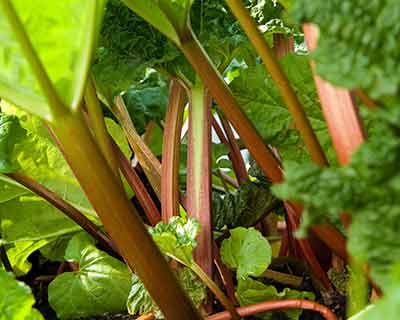Rheum × hybridum
Rhubarb is a remarkable plant – a vegetable that thinks it’s a fruit; a medicinal purgative that became a delicacy; grown in the dark but, like a sorrel on steroids, eventually reaching gigantic proportions; a treat for the eyes as well as the tastebuds. The RHS is committed to conserving these strange and noble garden favourites and now have just the place to do it.
Rhubarb’s affinity with the north of England is longstanding and well known. In the late 19th and early 20th centuries the ‘Rhubarb Triangle’ – an area of West Yorkshire between Leeds, Bradford and Wakefield – became a powerhouse of rhubarb production, the cut stems raced on a train service known as the ‘Rhubarb Express’ to the hotels and markets of London. At the peak of the trade, as much as 200 tonnes of rhubarb per day was shuttled south in the season between Christmas and Easter.
The high value placed on rhubarb was due to the special way it was grown or ‘forced’. Having been beefed up for a couple of years on a diet of fertile soils and plentiful moisture, the rhubarb crowns would be transferred to dark, heated sheds. The blanched stems the plants were ‘forced’ to produce by the heat were sugar-rich and tender, harvested by candlelight to prevent any trace of
The Rhubarb Triangle is still recognised today but is reduced to just nine square miles. Only in this area can stems designated ‘Yorkshire forced rhubarb’ be produced according to the Protected Food Name scheme.
Growing in the garden
The rhubarb collection at RHS Garden Bridgewater is not subject to so intensive a cultivation regime as its gourmet counterparts but it nevertheless thrives under the vigilant care of Caroline Williamson, Team Leader of the Outer Walled Garden.“Choose a sunny spot or light shade,” Caroline advises those wishing to grow their own rhubarb. “The soil should be moist but free-draining to prevent the crown rotting.
Rhubarb, as it is grown today, is mostly a
Resilience aside, the larger the number of cultivars that can be conserved the more future-proofed to a changing climate rhubarb will be in the UK. That’s where the National Collection comes in.
“The number of rhubarb growers has diminished so we are left with a handful of varieties readily available,” warns RHS Garden Bridgewater Curator, Marcus Chilton-Jones. “The rise in local food sourcing and artisan bakes is reinvigorating rhubarb growing and chefs are searching for the rarer local varieties.”
Personal favourites
“I like ‘Timperley Early’, a local variety from the south of Manchester,” says Marcus. “For a great workhorse, ‘Baker’s All Season’ is one of the varieties that continues to produce up to autumn yet is earliest to send up new shoots in spring. For flavour, the ‘Champagne’ varieties have a lighter, sweeter taste, similar to forced rhubarb.” Wherever you garden in the UK, rhubarb can make a long-lasting, low maintenance and tasty crop but it is pleasing to think of the National Rhubarb Collection growing at last in a climate where it can flourish to its full potential.
Caroline Williamson says: “I am really happy to have the Rhubarb Collection back in the north where it belongs. Seeing crates of rhubarb going to the kitchen is a joy to behold and the gluten-free rhubarb sponges they create are gorgeous! My own favourite way of cooking rhubarb is to poach it in the oven with the juice and rind of an orange plus honey, eaten hot with ice cream or cold with plain yoghurt. Delicious.”

